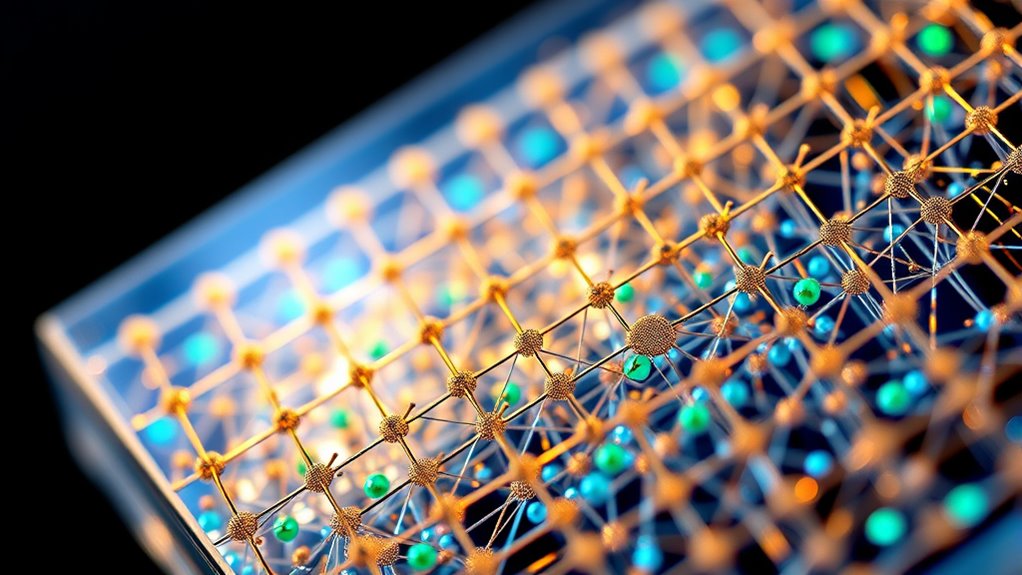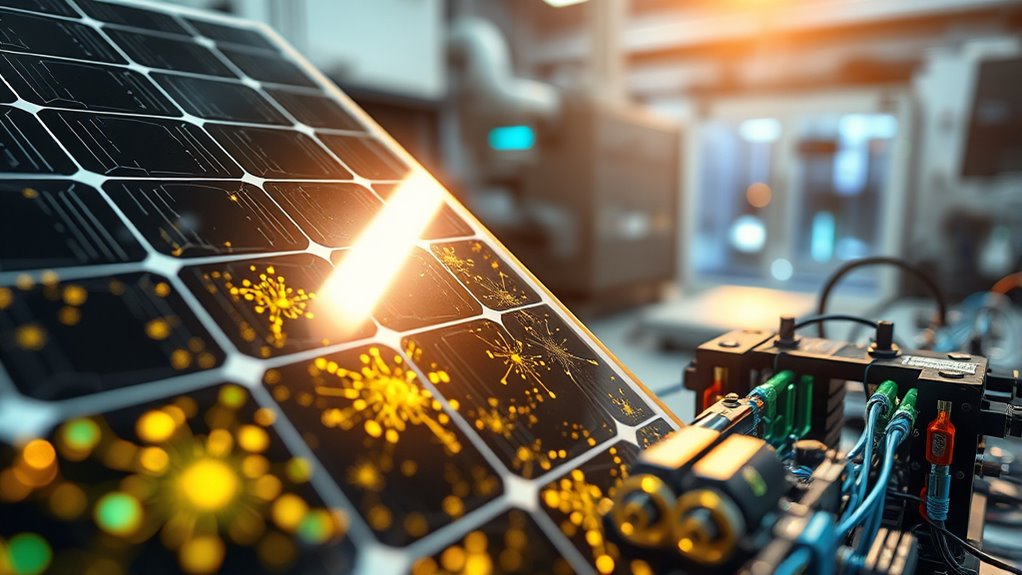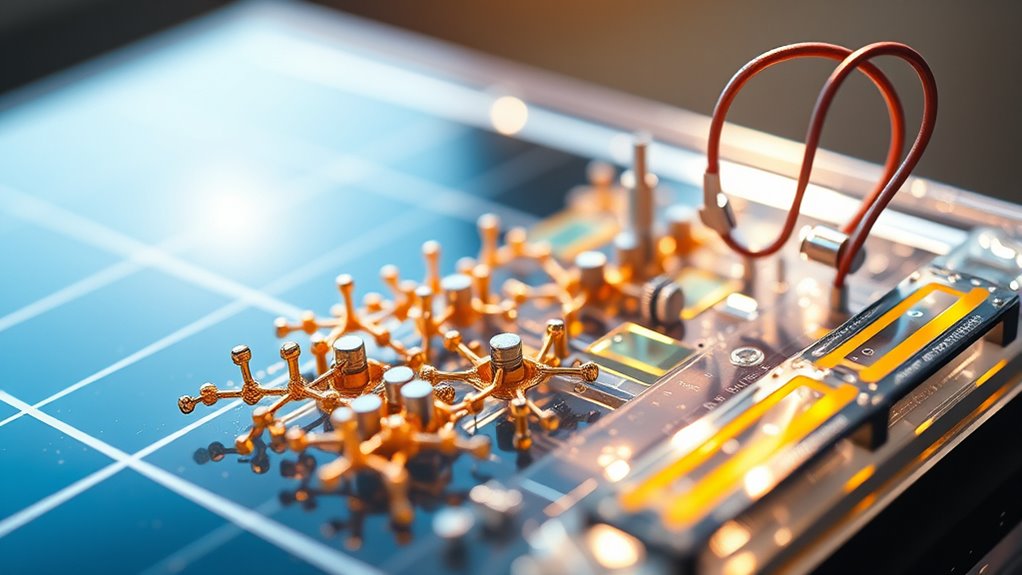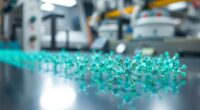Nanomachines enhance renewable energy by improving solar cell and fuel cell performance. They manipulate light and materials at the nanoscale to boost efficiency, reduce reflection, and increase charge absorption. In fuel cells, they optimize catalysts and improve durability. This nanoscale engineering makes devices more efficient, durable, and cost-effective. If you continue exploring, you’ll discover how these tiny innovations are shaping the future of sustainable energy solutions.
Key Takeaways
- Nanomachines enhance solar cell efficiency by trapping light and improving electrical properties at the nanoscale.
- They optimize catalyst activity and electrode durability in fuel cells, boosting chemical conversion performance.
- Nanoscale engineering increases light absorption, surface area, and durability of renewable energy devices.
- Challenges include ensuring nanomachine stability, scalable manufacturing, and environmental safety.
- Emerging applications feature lightweight solar panels, self-healing materials, and real-time performance sensors.
Enhancing Solar Cell Efficiency With Nanomachines

Nanomachines play a crucial role in boosting the efficiency of solar cells by precisely manipulating light and materials at the nanoscale. They help you capture more sunlight by optimizing the way light interacts with the solar cell surface. For example, nanomachines can create tiny structures that trap light, reducing reflection and increasing absorption. They also enable you to engineer materials with improved electrical properties, allowing for faster electron movement and less energy loss. This precise control helps you design solar cells that convert sunlight into electricity more effectively. By tailoring surface textures and material interfaces at the nanoscale, nanomachines make solar technology more efficient and cost-effective, pushing renewable energy closer to widespread adoption. Additionally, innovations in renewable energy technologies are expected to increase overall system efficiency, further enhancing the contribution of nanomachines to sustainable power generation.
Nanomachines in Fuel Cell Technology

Building on how nanomachines improve solar cell efficiency, they also revolutionize fuel cell technology by enabling precise control over chemical reactions and material interfaces. You can harness nanomachines to optimize catalyst activity, reducing energy losses during conversion processes. They facilitate uniform distribution of reactants and improve electrode durability, leading to longer-lasting fuel cells. Nanomachines can even tune surface properties at the atomic level, enhancing reaction rates and selectivity. This precision allows you to design more efficient and cost-effective fuel cells, with better performance under varied conditions. They also enable material customization at the nanoscale, further improving functionality. This level of control enhances overall system performance and durability, making renewable energy solutions more viable. As a result, fuel cells become more reliable and scalable for real-world energy needs. By integrating nanomachines, you push the boundaries of current fuel cell capabilities, making renewable energy storage and conversion more practical and sustainable.
Advantages of Nanoscale Engineering in Renewable Energy Devices

Nanoscale engineering offers significant advantages in enhancing the performance and efficiency of renewable energy devices. By manipulating materials at the atomic level, you can create structures that improve light absorption in solar cells, leading to higher energy conversion rates. Nanoscale features also increase surface area, boosting catalytic activity in fuel cells and enabling faster reactions. Additionally, nanoscale coatings can enhance durability, making devices more resistant to environmental factors. You gain the ability to tailor electrical and optical properties precisely, optimizing device performance. This level of control reduces material waste and allows for lighter, more flexible, and cost-effective energy solutions. Furthermore, understanding the contrast ratio in projectors can be applied to improve display technologies used in energy monitoring systems. Overall, nanoscale engineering *unlocks* new potential for making renewable energy devices more efficient, durable, and adaptable to various applications.
Challenges and Future Prospects of Nanomachine Integration

While nanoscale engineering has revealed impressive advancements in renewable energy devices, integrating nanomachines into practical systems presents several hurdles. You face challenges in ensuring stability, as nanomachines can degrade under environmental conditions like heat, moisture, and UV exposure. Scalability remains a concern; producing complex nanostructures consistently and cost-effectively is difficult. Precise control over nanomachine placement and operation at a large scale is another obstacle. Additionally, you must address potential toxicity and environmental impact, ensuring safe deployment. Future prospects depend on developing robust fabrication methods, improving durability, and reducing costs. Advances in self-assembly, adaptive materials, and scalable manufacturing techniques will be vital. Incorporating headphone compatibility considerations and standards can facilitate integration with various devices and systems. Overcoming these challenges will determine how effectively nanomachines can revolutionize renewable energy technologies in real-world applications.
Real-World Applications and Emerging Developments

Have nanomachines truly begun transforming renewable energy systems? Yes, they’re making a difference. In solar cells, nanomaterials boost efficiency by improving light absorption and charge transport, leading to more affordable and durable panels. Researchers are integrating nanomachines into fuel cells, enhancing catalytic activity and reducing costs. You’ll see nanotechnology-driven sensors monitoring system performance in real-time, optimizing energy output. Emerging developments include flexible, lightweight solar panels and self-healing materials that extend lifespan. Commercial applications are gradually expanding, with some nanotech-enhanced devices already in use. As these innovations progress, you’ll notice more efficient, cost-effective renewable energy solutions becoming part of everyday life. The integration of nanomachines is not just theoretical anymore; it’s actively shaping the future of sustainable energy systems. Asset division strategies can also benefit from emerging technologies to optimize resource management and legal processes.
Frequently Asked Questions
How Do Nanomachines Affect the Environmental Sustainability of Renewable Energy?
Nanomachines improve environmental sustainability by making renewable energy sources more efficient and durable. You benefit from cleaner energy production with fewer pollutants and waste. They help extend the lifespan of solar cells and fuel cells, reducing replacement needs. Plus, their precise control minimizes material use, lowering environmental impact. Overall, nanomachines enable you to harness renewable energy more effectively, supporting a healthier planet and sustainable future.
What Are the Cost Implications of Integrating Nanomachines Into Energy Devices?
Integrating nanomachines into energy devices can initially increase costs by up to 50%, but they markedly boost efficiency and lifespan. You’ll see long-term savings through reduced maintenance and higher energy output. While development expenses are high now, advancements are driving prices down. Ultimately, investing in nanomachines can make renewable energy more affordable and sustainable, helping you save money while supporting environmental goals.
Are There Safety Concerns Related to Nanomachine Deployment in Renewable Tech?
Yes, there are safety concerns when deploying nanomachines in renewable tech. You need to take into account potential toxicity, environmental impact, and unintended interactions with ecosystems. You should ensure proper containment, rigorous testing, and regulation to minimize risks. Staying informed about ongoing research and adhering to safety protocols helps protect both human health and the environment while advancing nanomachine applications in renewable energy.
How Scalable Are Nanomachine Manufacturing Processes for Commercial Use?
You can scale up nanomachine manufacturing for commercial use, but it’s challenging. Current processes are mostly lab-based and need to become more efficient and cost-effective. Advances in automated production, better materials, and streamlined techniques are helping. However, achieving large-scale, reliable manufacturing still requires significant research and investment. With ongoing innovation, you’ll see nanomachines becoming more practical for widespread renewable energy applications in the future.
What Regulatory Frameworks Oversee Nanomachine Use in Energy Applications?
You’ll find that regulatory frameworks overseeing nanomachines in energy applications are still evolving, much like a delicate tapestry being woven. Agencies like the FDA, EPA, and international bodies are gradually developing guidelines to guarantee safety and efficacy. These regulations focus on environmental impact, safety standards, and ethical considerations. Staying informed and engaged with policymakers will help you navigate this emerging landscape as standards continue to develop and refine.
Conclusion
Think of nanomachines as tiny engineers revolutionizing your energy future, much like a master craftsman perfecting a delicate clock. They boost solar cell efficiency by capturing more sunlight and power fuel cells more effectively. With ongoing advancements, you’re on the brink of a cleaner, sustainable world where these microscopic devices open up endless potential. Embrace this tiny technology, because in the domain of renewable energy, small truly makes a big difference.









